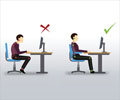If your job requires long hours of sitting then getting up from your desk and walking around a little every 20 minutes or so could help your body more than a 45-minute session at the gym, say experts.

"You might feel that you're justifying your desk-bound position by going to the gym. But your body will benefit more if you get up and move around. Even doing things like standing when you're trying to plan meetings, or going across the room to talk to someone, can help keep the body awake," he said.
When walking through an office, Atlas often can correctly predict physical ailments just by looking at how someone sits at the desk. And sometimes, an attempt at good posture only contributes to the problem.
"We're taught to sit up straight but most people sit forward in their chairs, leaning into the screen," said Rick Olderman, author of Fixing You: Shoulder and Elbow Pain. The result is shoulder and lower-back pain, he said.
One answer: set the chair at a lower height to let your knees be even with your hips and scoot back in the seat until your spine contacts the chair's backrest.
Most people unconsciously succumb to one or more of three positions that can cause injuries that range from lower-back to carpal-tunnel problems. The first is what Atlas calls 'the Sloucher'-sitting slumped, hips forward, the middle of the back leaning against the back of the chair.
The third is 'the Designer Lean', named for graphic designers who tilt slightly toward their hand as it sits on the mouse. Their torso is still, except for the subtle, sporadic motion of hand on mouse.
The Sloucher has tight hip flexors that pull the lower back forward into a swayback, even when the Sloucher stands. It contributes to lower-back pain and poor digestion.
The Facebook Lean puts enormous stress on the erector muscles of the upper back and neck-the same muscles that help support the head. In this position, Atlas explains, chest muscles tighten, shoulders round forward, forearms rotate internally and wrists tilt, all contributing to carpal-tunnel problems and neck pain.
Graphic designers are especially prone to the Designer Lean, which shortens muscles on one side of the lumbar spine and lengthens muscles on the other. The position encourages someone to sit off-centre, making it hard for muscles to right themselves when the user stands up.
Source-ANI
 MEDINDIA
MEDINDIA




 Email
Email








